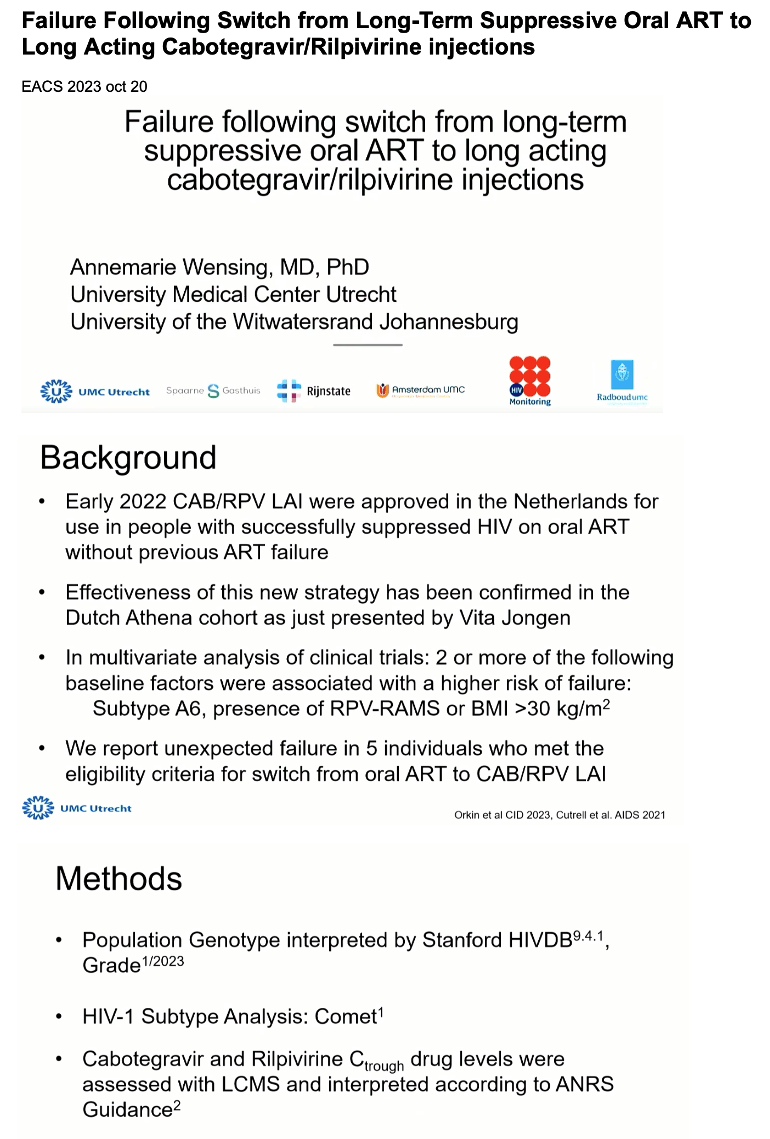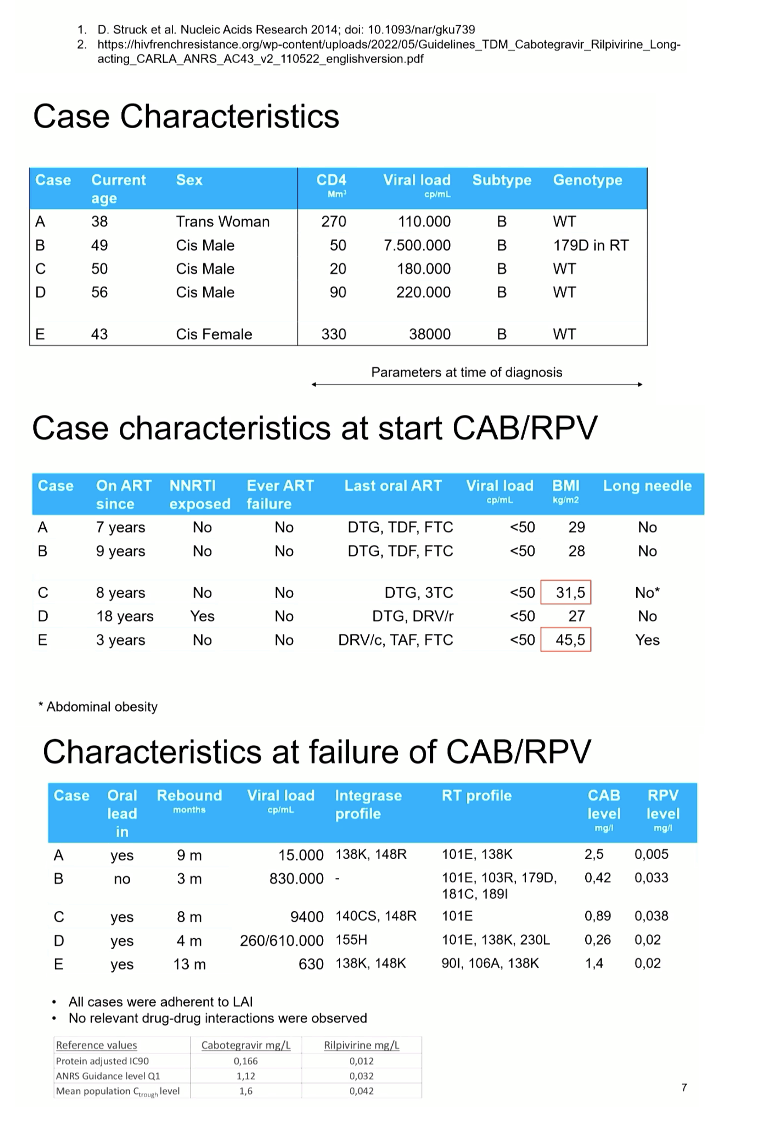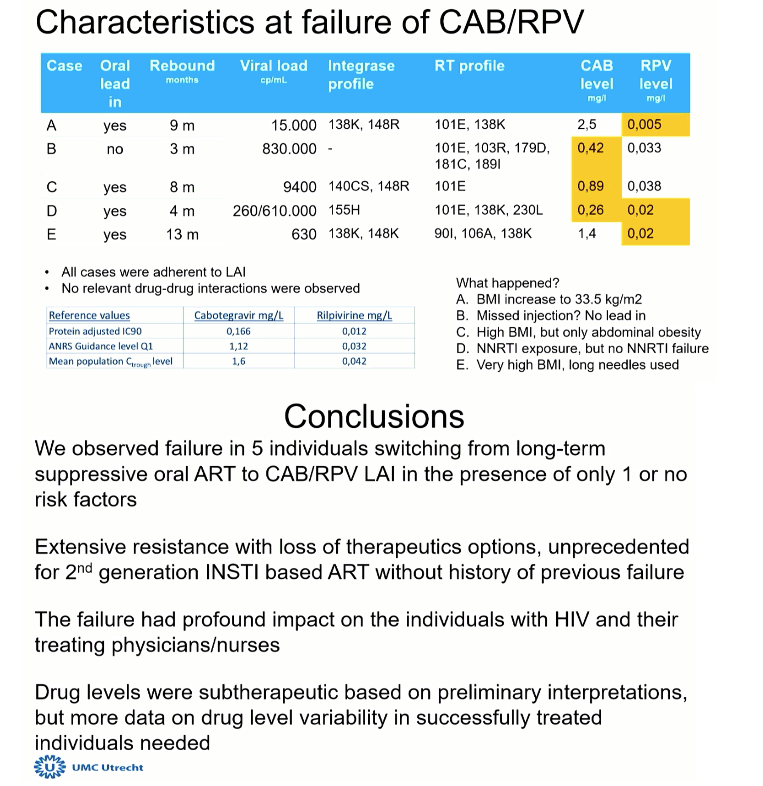 |
 |
 |
| |
Long-Acting CAB + RPV Fails With Resistance in 5 After Long Control on Oral Regimens
|
| |
| |
EACS 2023, October 18-21, 2023, Warsaw
Mark Mascolini
Five people who controlled HIV for years with oral antiretroviral regimens had virologic failure with emergence of integrase inhibitor and/or nonnucleoside resistance mutations after they switched to injected cabotegravir plus rilpivirine (CAB + RPV) [1]. CAB or RPV levels were low in two people, but only 2 were overweight or obese when they started the injected antiretrovirals. No one had other known risk factors for CAB + RPV failure.
Long-acting injected CAB + RPV got licensed in the Netherlands and elsewhere for people who maintain an undetectable viral load with oral antiretrovirals and have no previous regimen failure. CAB + RPV injected every 4 or 8 weeks has generally worked well in the Netherlands, as another talk at EACS 2023 documented [2].
In presenting the 5 failure cases, Annemarie Wensing of University Medical Center Utrecht noted that multivariate analysis of CAB + RPV trials identified three baseline factors linked to virologic failure: HIV-1 subtype A6, RPV-associated resistance mutations, and body mass index above 30 kg/m(2), which puts a person into the obese range.
Ages of the 5 people ranged from 38 to 56; 1 was a trans woman, 3 cisgender male, and 1 cisgender female. All had subtype B HIV-1. When diagnosed with HIV their CD4 counts were 20, 50, 90, 270, and 330 and their viral loads ranged from 38,000 to 7.5 million copies. Before CAB + RPV began, 1 person had a naturally occurring mutation, 179D in reverse transcriptase, a substitution associated with the nonnucleoside etravirine [3].
These 5 people had taken antiretroviral therapy for 3, 7, 8, 9, and 18 years. One had taken a nonnucleoside earlier, and no one ever had a virologic failure. Four people switched to CAB + RPV from a dolutegravir regimen and one from a cobicistat-boosted darunavir combination. All had a viral load below 50 copies at the switch. Two people were obese (body mass index 31.5 kg/m2 and 45.5 kg/m2. A long needle was used for CAB + RPV injections in the obese person, a woman.
Viral rebounds occurring 3, 4, 8, 9, and 13 months after the switch ranged from 9400 to 830,000 copies. Four of the 5 people had mutations in viral integrase and all 5 in reverse transcriptase. Drug level monitoring indicated low concentrations of CAB in 3 people and RPV in 3. One person had low levels of both drugs. The researchers called these subtherapeutic levels "preliminary interpretations" and added that researchers need more data on antiretroviral concentration variability in people whose CAB + RPV does not fail.
Wensing and colleagues at other Netherlands centers did not venture any interpretations of CAB + RPV failure in these people. Wensing noted a few points about each person. One had a body mass index that began in the normal range and rose to 33.5 kg/m2 during gender transition. Another had no oral drug lead-in to the injected agents and may have missed an injection. A third had a high body mass index but only abdominal obesity. A fourth had taken a nonnucleoside but had no history of nonnucleoside regimen failures. The fifth person had high-level obesity (45.5 kg/m2) requiring a long needle for CAB and RPV injections.
The researchers noted that everyone had "extensive resistance with loss of therapeutic options, unprecedented for second-generation integrase inhibitor-based antiretroviral therapy without a history of previous failure." They added that these failures had a "profound impact" on the treated people as well as on the health professionals who cared for them. As another presentation at this EACS 2023 session explored 5 cases of virologic failure in 588 people taking CAB + RPV in the Netherlands, for a failure rate of 0.9% [2] (reported separately by NATAP).
References
1. van Welsen BJ, van Lelyveld S, ter Beest G, et al. Failure following switch from long-term suppressive oral ART to long-acting cabotegravir plus rilpivirine. EACS 2023, October 18-21, 2023, Warsaw.
2. Jongen V, Wit F, van Eeeden A, et al. Effectiveness of injectable long-acting cabotegravir and rilpivirine for the treatment of HIV-1: results from the Dutch ATHENA national observational cohort. EACS 2023, October 18-21, 2023, Warsaw.
3. Wensing AM, Calvez V, Ceccherini-Silberstein F, et al. 2022 Update of the drug resistance mutations of HIV-1. Topics in Antiviral Medicine. 2022;30:559-574. https://www.iasusa.org/wp-content/uploads/2022/10/30-4-559.pdf



|
| |
|
 |
 |
|
|